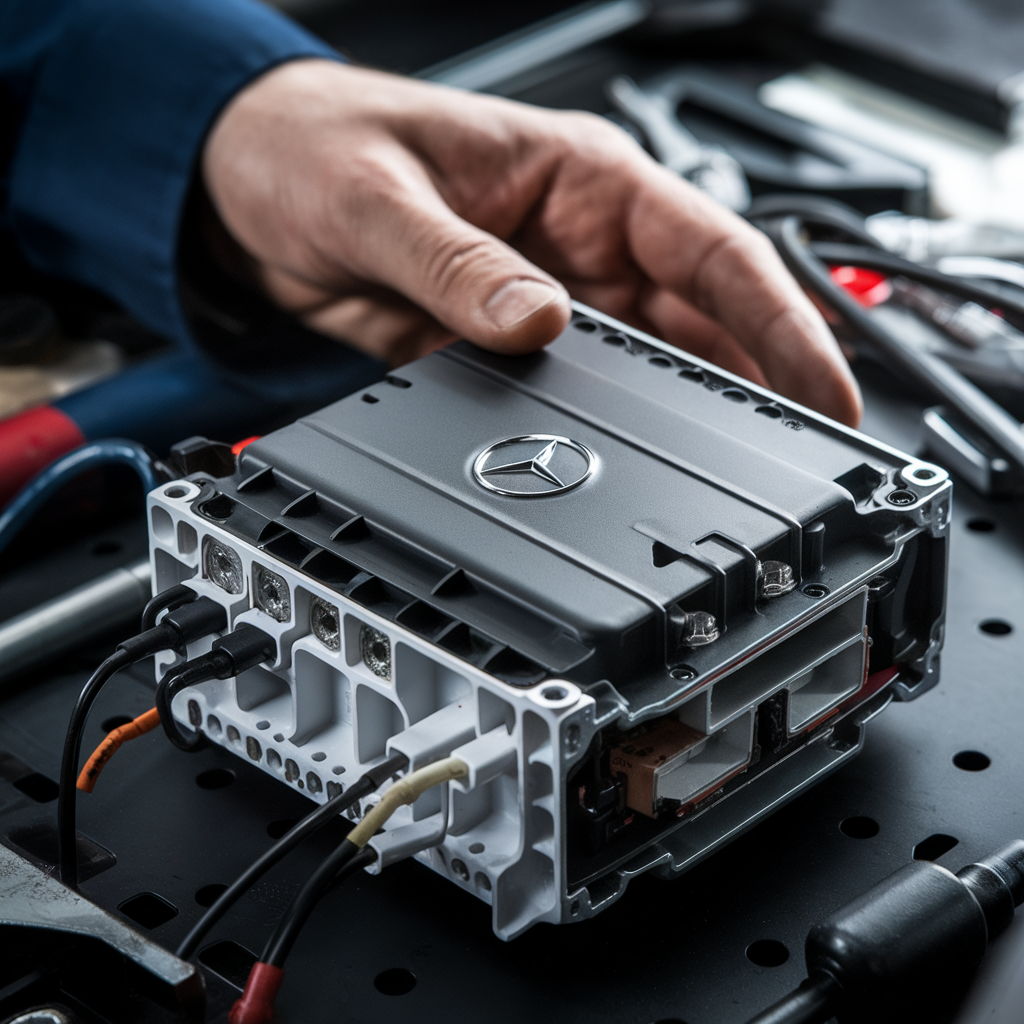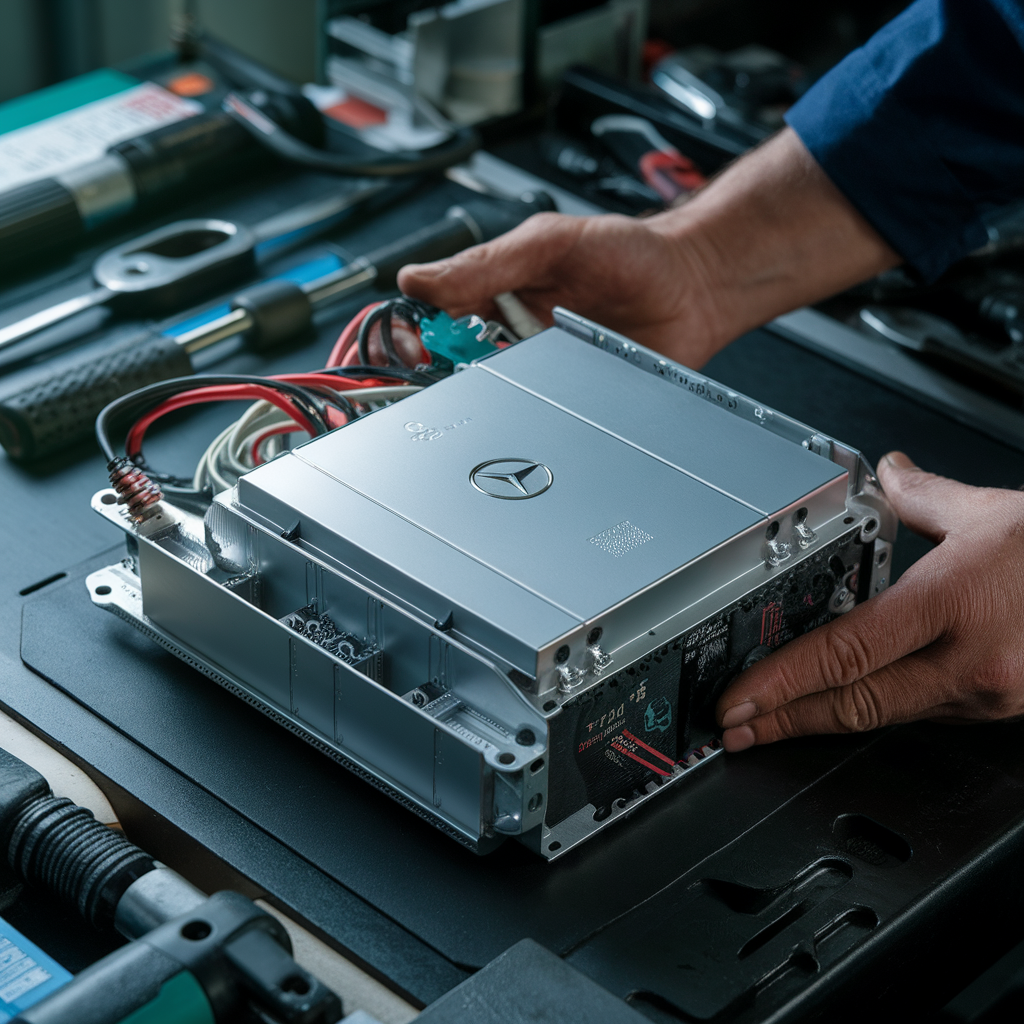Expert Mercedes Module Repair Services in Dubai
Getting module failure alerts on your Mercedes, like gear not shifting, steering lock stuck, or no ignition response? You are likely dealing with a faulty ECU, TCU or EIS module, all of which are critical to your car’s performance and safety. Over 70% of Mercedes module issues in Dubai are caused by heat, voltage spikes, or software corruption, especially in models like the W204, W212 and A-Class CVT variants. At our Mercedes garage, we repair and reprogram all major modules including ABS, SAM, EZS and TPMS sensors, using factory, level tools like Xentry and Launch X431. We back our work with original parts and precise coding that matches your VIN. Book your Mercedes module repair today and get up to 15% off your first module service, limited time offer.
What Causes Mercedes Module Failures?
Most Mercedes module failures are not random, they result from very specific, measurable factors. These are the most common real, world causes we see in our Dubai Mercedes garage:
- Repeated Overheating of ECU and TCU Modules
When the Engine Control Unit (ECU) or Transmission Control Unit (TCU) is located near the engine bay (e.g., in W204 or W211 models), it is exposed to temperatures exceeding 100°C. This constant heat weakens solder joints and degrades internal capacitors over time. - Power Surges During Battery Changes or Jump, Starts
If the vehicle is jump-started without a voltage stabilizer, sudden surges of 13.8V–16V can damage microprocessors in modules like EIS, EZS, and ISM. This often leads to “no communication” faults when scanned.
Water Damage to SAM and ECU Units
The Signal Acquisition Module (SAM) is usually installed under the driver, side dashboard or fuse box. Even minor AC drainage issues or water pooling during pressure washes can corrode terminals and fry circuit boards.
Gear Selector Motor Burnout in ISM Modules
On models like the Mercedes E, Class W212 or S, Class W221, frequent short trips with high gear engagement can overheat the Intelligent Servo Module (ISM), causing gear locking or inability to shift out of park. - Mechanical Lock Failure in ESL (Steering Lock)
In W204, W207, and W212, the Electronic Steering Lock (ESL) uses a plastic gear motor that tends to break after 70,000–90,000 km, leading to a locked steering wheel and ignition failure. - Valve Body Sensor Errors in CVT Control Modules (722.8)
A-Class and B, Class models with the CVT gearbox have internal speed sensors on the valve body. Over time, heat and metallic debris cause sensor failure, triggering limp mode or gear, hunting issues. - Aging TPMS Sensor Batteries
Each TPMS sensor has a sealed battery. After 5–6 years or 80,000 km, these batteries deplete, causing inconsistent or missing pressure readings, especially in Dubai’s high, heat tire conditions. - Incorrect Coding After Module Replacement
Some garages install new modules without performing SCN coding or VIN matching, which prevents communication with other vehicle systems and triggers permanent fault codes.
These are not hypothetical reasons, they are real, testable failures we diagnose regularly. Using proper diagnostic tools like Xentry, we determine exactly which factor has caused the module to fail, and whether it is repairable, reprogrammable, or needs replacement.
List of Mercedes Modules We Repair
We handle a wide range of Mercedes electronic modules that frequently fail due to heat, electrical overload, mileage, related wear, and water damage, especially in Dubai conditions. Below is a detailed list of the Mercedes modules we repair, along with the specific faults we address in each:
- Mercedes ECU Repair (Engine Control Unit) , Fixes engine stalling, injector misfire, throttle lag, and corrupted firmware due to overheating or voltage spikes.
- Mercedes TCU / TCM Repair (Transmission Control Unit / Module) , Resolves gear shift delays, limp mode, harsh transitions, and signal loss caused by internal driver faults or software failure.
- Mercedes CVT Module Repair (722.8) , Repairs clutch sensor errors, RPM mismatch, and gear, hunting issues in A, Class and B, Class CVT models.
- Mercedes EIS Repair (Electronic Ignition Switch) , Fixes no, crank conditions, key not turning, and ignition recognition failure often linked to transistor damage or memory loss.
- Mercedes ESL Repair (Electronic Steering Lock) , Restores steering unlock function and ignition sync by repairing or replacing failed lock motors in W204, W207, and W212 models.
- Mercedes EZS Repair (Electronic Ignition Steering Control) , Corrects failed key responses, central locking errors, and EEPROM data faults within the ignition communication system.
- Mercedes SAM Module Repair (Signal Acquisition Module) , Fixes lighting malfunctions, non, working wipers, horn failures, and signal issues caused by water intrusion or blown traces.
- Mercedes ISM Module Repair (Intelligent Servo Module) , Solves gear selector lock, stuck-in-park faults, and servo malfunction due to gear motor burnout or faulty range data.
- Mercedes ABS Module Repair (Anti, lock Braking System) , Repairs faulty ABS pump relays, wheel speed sensor errors, and ABS warning light triggers caused by module failure.
- Mercedes ECM Repair (Engine Control Module) , Restores idle control, sensor signal processing, and ignition timing by correcting board, level faults and restoring voltage regulation.
- Mercedes TPMS Sensor Replacement (Tire Pressure Monitoring System) , Replaces battery, dead TPMS sensors, resolves false alerts, and recalibrates pressure readings using OEM, compatible sensors.
All repairs include bench testing, firmware recovery, and module reprogramming using VIN-matching procedures. Our repair process ensures the module integrates seamlessly back into your Mercedes’ network, without triggering new faults.
Our Mercedes Module Repair Process
We follow a structured, hands-on diagnostic and repair approach using dealer, level tools and factory, approved methods, right here in our Dubai workshop. Mercedes modules like ECU, EIS, TCU, and SAM are sensitive to power fluctuations, heat, and firmware mismatches. Replacing them isn’t always necessary. With the right tools, reprogramming access and component, level expertise, most modules can be repaired and restored to original specs. Here’s how we do it, step by step.
1. Fault Code Scan with Xentry
We begin by connecting the vehicle to Mercedes Star Diagnostic (Xentry) or Launch X431 Pro3. These tools communicate with every onboard module to detect current faults, history logs, and CAN communication losses. This step identifies which control unit has failed, whether it is the ECU, EIS, SAM, TPMS, or ABS, and whether the fault is internal or caused by a sensor or voltage issue.
2. Voltage Stabilization & Battery Check
3. Safe Module Removal
Using official wiring diagrams from Mercedes WIS (Workshop Information System), we label connectors, identify CAN, L and CAN, H lines, and follow proper grounding disconnection procedures. Modules like SAM, TCU, or EIS are fragile, especially those mounted in fuse boxes or under steering columns, so anti, static precautions are taken before handling.
4. Bench Testing & Signal Simulation
5. Firmware Flashing & Coding
6. Reinstallation & Full System Test
The repaired module is reinstalled and the system is re, scanned with Xentry. We clear all existing DTCs, reinitialize the module, and test live functions, such as ignition, gear response, ABS performance, or steering unlock. If needed, we perform adaptation procedures (e.g., for ISM or EZS) to ensure system pairing is successful.
Mercedes Benz Models We Support for Module Repair
Our workshop in Dubai specializes in Mercedes module repair for a wide range of models, from entry, level saloons to luxury AMG variants. Each model has its own set of common electronic failures, and we’re fully equipped to diagnose and repair these with VIN, matched coding, OEM tools, and in, house testing equipment.
- Mercedes C, Class (W204, W205, W206)
- Common issues: EIS failure, ECU overheating, SAM water damage, and ABS pump relay faults.
- Mercedes E, Class (W211, W212, W213)
- Known for ISM module errors, TCU signal faults, and CVT module failures in earlier variants., Mercedes S, Class (W221, W222)
- Frequent faults: EZS failure, steering lock module, and corrupted TPMS sensor readings.
- Known for ISM module errors, TCU signal faults, and CVT module failures in earlier variants., Mercedes S, Class (W221, W222)
- Mercedes A, Class and B, Class (W169, W245, W176)
- Often require CVT control unit repairs (722.8), TPMS replacements, and SAM circuit recovery.
- Mercedes GLC / GLE / GLS SUVs
- Suffer from ECU water damage, EIS/EZS communication faults, and gear shift module (ISM) failures.
- Mercedes CLA / CLS / GLA Series
- We handle ECU tuning repairs, ABS errors, and EIS, related ignition failures for these models.
- Mercedes Vito / Sprinter (Commercial Models)
- Common repairs include EIS and ESL units, SAM board corrosion, and TPMS sensor replacement.
Whether your vehicle is from 2007 or 2023, we provide Mercedes module repair for all major platforms using dealer-grade tools like Xentry, Vediamo, and EEPROM programming kits. All repairs are VIN, matched, road, tested and guaranteed for full system integration.

Tools & Software We Use for Mercedes, Benz Module Repair
We rely on dealer, level diagnostic tools and programming software to ensure every Mercedes module repair we perform is accurate, safe, and fully integrated with the vehicle’s system. These tools allow us to carry out tasks like SCN coding, firmware flashing, EEPROM reprogramming and voltage signal analysis, all necessary for repairing critical modules like the ECU, TCU, EIS, and SAM. Here’s a breakdown of the exact tools and software we use in our Dubai workshop:

- Mercedes Star Diagnostic (Xentry) , Factory tool used to scan, code, and adapt control units such as ECU, TCU, SAM, EIS, and ABS. It supports SCN coding, module calibration, and real, time communication analysis across all vehicle systems.
- Vediamo & DTS Monaco , Advanced coding software used to perform offline programming, EEPROM unlocking, and firmware configuration for modules like EIS, EZS, ISM, and ESL, especially when SCN coding is restricted.
- EEPROM Programmers (XProg, TL866II Plus, Orange5) , These allow us to read, edit, and flash firmware stored in microchips during ECU, EIS, or ESL repairs. Essential when dealing with corrupted memory or performing VIN re-sync.
- PicoScope & Fluke Multimeters (88V Series) , Used for precise circuit diagnostics. These tools help us trace voltage drops, detect shorted paths, and measure live CAN signals in modules like SAM, ABS, and CVT units.
- CAN Signal Simulators & Bench Testing Tools – We use these to simulate real-world signal inputs when testing modules outside the car. This is especially useful when validating ISM module gear signals or verifying ESL lock/unlock commands.
- DC Power Supply Units (13.6V Stabilizers) , Used during programming to maintain stable voltage and prevent firmware corruption. Crucial when flashing ECU or conducting long adaptation processes on TCU modules.
Mercedes WIS & EPC (Workshop Information System & Parts Catalog) , Provides official wiring diagrams, connector layouts, and module placement guides. We use these references during safe module removal and reinstallation to avoid incorrect connections.
These tools are not just for diagnostics, they allow us to repair modules at the circuit and software level with dealership, grade precision. By using this equipment, we ensure every Mercedes module repair is done professionally, with full system compatibility and long-term reliability.
Mercedes Module Repair Cost in Dubai
Module Type | Estimated Repair Cost (AED) | SCN Coding / Reprogramming |
ECU (Engine Control Unit) | 950 – 1,450 | Included |
TCU / TCM (Transmission Module) | 1,200 – 1,800 | Included |
CVT Module (722.8) | 1,300 – 1,900 | Included |
EIS (Electronic Ignition Switch) | 950 – 1,300 | Additional AED 250–350 |
ESL (Electronic Steering Lock) | 950 – 1,400 | Additional AED 250–350 |
EZS (Ignition Steering Control) | 1,100 – 1,500 | Included |
SAM Module | 900 – 1,250 | Included |
ISM (Gear Selector Module) | 1,200 – 1,600 | Included |
ABS Module | 950 – 1,350 | Included |
ECM (Engine Control Module) | 950 – 1,400 | Included |
TPMS Sensor Replacement (per wheel) | 250 – 350 | Included |
Note: Final pricing depends on model, year, and module condition. For example, W212 and W221 models may require extended coding time or additional firmware recovery. We also offer pickup and drop-off services anywhere in Dubai. First-time customers get 10% off on module repairs.
Why Choose Our Garage in Dubai for Mercedes Module Repair
When it comes to Mercedes module repair in Dubai, precision, tools, and technical understanding matter. Many garages either replace entire units unnecessarily or lack the software to code modules back into the system. That is where we stand apart, with real diagnostics, in-house coding, and repair, not replacement by default. Here’s why more Mercedes owners across Dubai trust us with their module issues:
- Over 1,000 Mercedes Modules Repaired Locally
We have successfully repaired and reprogrammed more than 1,000 ECU, TCU, EIS, and SAM modules across W204, W212, W221, and A-Class platforms, all within our own facility in Al Quoz, Dubai. - Dealer-Level Tools and OEM Software Access
We use Mercedes Star Diagnostic (Xentry), Vediamo, and EEPROM programmers, the same tools used in authorized Mercedes service centers, to ensure exact SCN coding, VIN matching, and firmware flashing. - 24–48 Hour Turnaround for Most Modules
Most Mercedes module repairs are completed in 1 to 2 working days, including reinstallation and road testing. For common repairs like ESL or SAM, same, day service is available depending on workload. - Transparent Costs and First, Time Discount
We provide upfront pricing with no hidden fees, and our customers receive a 10% discount on their first module repair. Every job includes diagnostics, testing, and detailed reporting.
Whether your module is water-damaged, corrupted, or completely unresponsive, we deliver fast, reliable, and VIN-specific solutions using the latest diagnostic technology. Book your Mercedes module repair today and experience dealership, level service, without the dealership price tag.
FAQs About Mercedes Module Repair in Dubai
It depends on the module. A failing ECU may still allow limited driving, but a bad TCU or EIS can result in no start, gear lock, or limp mode. Driving with a malfunctioning module can trigger cascading errors across other systems. We recommend having the vehicle scanned immediately to avoid permanent data corruption or immobilization.
Coding involves configuring a module to match the vehicle's options (lights, mirrors, features), while reprogramming refers to reinstalling or updating the module’s firmware or software. During Mercedes module repair, we often perform both—using tools like Vediamo and Xentry—to ensure full system compatibility, especially in EIS, SAM, and ECU repairs.
Our diagnostic scan helps determine if the issue is hardware-related (like burnt circuits in the SAM module) or software-based (like a corrupted ECU map). If components are intact, we proceed with internal board-level repair and firmware recovery. Full replacement is only advised when the module is completely dead or data-locked beyond recovery.
Yes, we offer module cloning services. If your original EIS, ECU, or ESL is non-functional, we can clone its data into a donor module—ensuring the new unit retains the same VIN, immobilizer sync, and functionality. This is a cost-effective solution when dealer coding is either unavailable or prohibitively expensive.
Yes. Our repairs follow manufacturer protocols and do not affect warranty eligibility unless the car is under new vehicle coverage with full dealership-only service history. We use VIN-specific SCN coding, ensuring future updates or coding events (e.g., at tire shops, gearbox resets) function normally.
For vehicles over 6 years old or 120,000 km, it's advisable to scan modules annually—especially EIS, ECM, and TCU—as aging circuits and memory chips start failing silently. In Dubai, the heat accelerates deterioration, so preventive diagnostics can save you from unexpected module failures.


